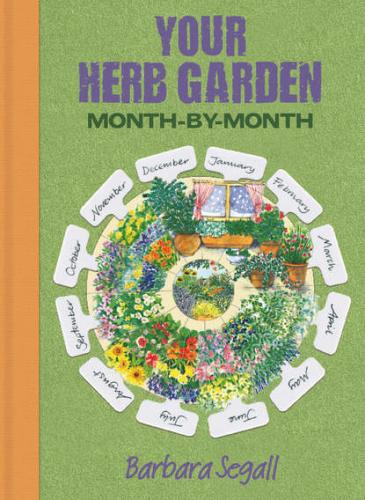JANUARY
If you are a first-time herb gardener, you are embarking upon one of gardening’S greatest pleasures. What better time than midwinter to start thinking about the aroma and fragrance of herbs in the spring or summer garden, as well as the household pleasures they provide throughout the year?
A herb garden offers a special combination of plants, which can be enjoyed in different ways. They can be admired simply for their decorative effect and overall shape, as they grow into the plan you have created. In addition, you can appreciate the scents, aromas and colours of their flowers and foliage.
Herbs can be raised from seed, grown from cuttings or bought in containers from garden centres or nurseries. During winter, in an established herb garden, fresh herb leaves are still available from many evergreen plants such as rosemary, thyme and sage. You can also grow a selection of herbs indoors on a sunny kitchen windowsill. Winter savory, chives, parsley, chervil, sage and thyme will all provide flavour for soups, stews, sauces and vegetable dishes through the winter season.
If you are new to herb gardening, use the calm and relative inactivity of this ‘in-between’ season to choose the site for your herb garden and the plants that you will use and enjoy. Then settle down to create a planting plan for the herb garden. Herbs are versatile plants that look equally attractive whether they are grown informal, shaped beds such as squares, rectangles and circles, or informal borders. If space is at a premium, plan a herb garden using containers on a balcony or patio, or even a windowbox.
Whether you are growing a herb garden for the first time, extending an existing one or adding a new herb feature to your garden, now is the time to choose or reassess the site and to make the right plant choices.
HERB THEMES FOR THE GARDEN
LEMON-SCENTED LEAVES
Balm • Lemon mint • Lemon thyme • Verbena
ORNAMENTAL DYE PLANTS
Coreopsis • Dyer’s chamomile • Safflower
EDIBLE FLOWERS
Bergamot • Borage • Garlic chives • Hyssop • Lavender • Mallow • Pot marigold • Rose • Sage • Viola
ENGLISH CULINARY
Chives • Mint • Parsley (curled) • Rosemary • Sorrel
FRENCH CULINARY
Bay • Chervil • Fennel • Garlic • Parsley • Tarragon • Thyme
ITALIAN CULINARY
Basil • Bay • Oregano • Parsley (flat-leaved) • Sage
POT-POURRI HERBS: FLOWERS
Lavender • Rose • Sage • Sweet rocket • Thyme
POT-POURRI HERBS: LEAVES
Basil • Bergamot • Mint • Scented pelargonium • Rosemary • Sage • Thyme • Wild strawberry
CHECKLIST
If you begin a herb garden in midwinter, most of your activity will be comfortably achieved indoors – drawing plans; ordering seeds and imagining the non-stop pleasure of harvesting throughout the following seasons. Now is the time to get to know the plants on paper; discover what conditions suit them best and check that you have the right soil and site for them. Then decide on the shape of the herb garden and the range of plants you want to grow.
NOTE
Herbs are adaptable plants that will grow in most conditions, extremes of cold, drought and moisture excluded. Most originate from hot climates and thrive in well-drained, infertile sandy soils. In the wild, herbs are not constantly harvested, so fertile soil is not necessary, and the aromatic oils produced in their leaves and stems help prevent excessive loss of water.
In the garden, you may have to offer the plants a little extra help to ensure they perform well. In cold areas, winter shelter from chilly, drying winds is necessary to prevent evergreens such as bay turning brown. In summer, the plants will benefit from the shelter and shade provided by herb hedges and wooden fencing.
If the soil is infertile, work in well-rotted, home-made compost or a bagged, proprietary compost in autumn or spring. The added compost gives the plants extra nutrients so they keep producing new shoots throughout the growing season. The addition of compost will also help water retention in dry soils. Heavy clay soils need similar additions of compost to open them up and prevent waterlogging. Clay soils also need gravel or coarse material such as sand worked in to make them free draining.
Choosing the site
For best results, choose a site in full sun, protected from cold or drying winds and with soil that is well manured, well dug and drains efficiently. Naturally, in exceptionally dry seasons you will have to water the plants. Remember that herbs in containers may need watering at least once a day, especially in sunny sites during dry, warm spells.
For you, easy access to the herb garden is essential. If you plan to grow herbs solely for kitchen use and have limited space, choose a site near the back door. That way, you can harvest fresh herbs in all weathers, just a step outside the kitchen.
Making a plan
